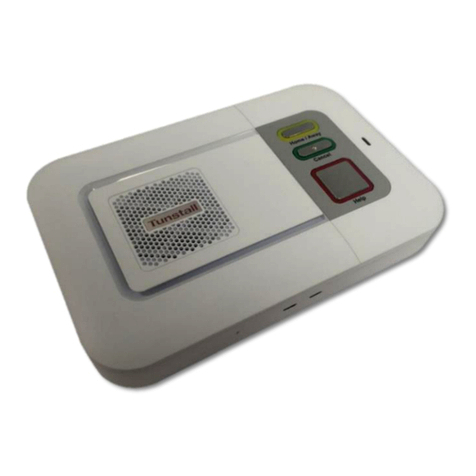
Lifeline Vi and Vi+ User Guide Technical Details
D5707001C1 Page 6 of 6
4Technical Details
Weight: 572g (939g packaged)
Dimensions: 185mm x 122mm x 41mm (WxLxD)
Mains power: 230v ac 13A electrical socket (3 Watts)
Standby battery: 2500mAhr capacity (continually internally charged)
Backup time: 40 hours of standby operation with one 30 minute alarm call
(minimum expected at date of purchase and when fully charged)
Radio frequency: 869.2125MHz, the European Social Alarm frequency band
Radio trigger power: The transmitted power in this band is less than 1mW e.r.p.
REN: 1
External connections: Telephone line cord with type BS6312 plug and 3m cable
DC power adapter with 3m cable
Radio trigger battery: 3V Lithium (not changeable) with up to 7 year life
4.1 Environmental
Temperature: Operating temperature (to perform to full specification) = 0°C to
45°C, storage = -10°C to 50°C
Humidity: Operating relative humidity (non-condensing to perform to full
specification) = 0 to 80%, storage relative humidity (non-
condensing) = 0 to 93%
4.2 Battery information
All batteries should be disposed of in accordance with the latest legislation.
4.3 Standards
EMC: EN55032, EN50130-4,
EN301 489-1, EN301 489-3
Safety: EN60950-1
Radio: EN300 220-2 Category 1
CE: Compliant
Social alarm: EN50134-1:2002, EN50134-2:1999 (trigger device)
Design, Manufacture, Installation and Service: ISO9001:2008
4.4 Declaration of Conformity
Tunstall declare that the radio equipment is in compliance with Directive 2014/53/EU. The
full text of the EU declaration of conformity is available at the following address:
www.tunstall.co.uk/approvals
Our policy of continual development means that product specification and appearance may change without
notice. Tunstall does not accept any responsibility for any errors or omissions contained in this document.
© 2019 Tunstall Group Ltd. ® TUNSTALL and LIFELINE are registered trademarks.
Tunstall Group Limited, Whitley Lodge, Whitley Bridge, Yorkshire DN14 0HR

























